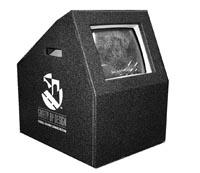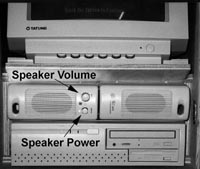

SAFETY BY DESIGN
"Moving Safely Across America"
Kiosk Manual
Table of Contents
Introduction
Chapter 1 – Unpacking and Set-up
Chapter 2 – Operating Fundamentals
|
Chapter 3
– Troubleshooting
Appendix A – Prudent Practices
|
This manual will guide you through the set-up and use of the "Moving Safely Across America" kiosk. This manual contains the following three chapters:
Chapter 1, Unpacking and Set-Up, explains how to unpack, set up, and connect the "Moving Safely Across America" kiosk.
Chapter 2, Fundamentals and Getting Help, outlines safety guidelines, turning the kiosk on and off, and repackaging the kiosk for shipping.
Chapter 3, Troubleshooting, explains how to diagnose and correct problems you may encounter when working with the kiosk.
Don’t miss information tagged "Warning!" This information warns of hazards to the kiosk.
Exhibit Planning and Shipping:
| Region 1 FHWA, Attn: James Growney Leo W. O'Brien Federal Building, Room 719 Clinton Avenue and North Pearl Street Albany, New York 12207 Phone: 518-431-4224 ext. 212 Region 3 Region 4 Region 5 Region 6 |
Region 7 FHWA, Attn: John Ballantyne PO Box 419715, Kansas City, MO 64141 Physical Address: 6301 Rockhill Road, 2nd Floor, Kansas City, MO 64131 Phone: 816-276-2730 Region 8 Region 9 Region 10 |
Chapter 1
Unpacking and Set-Up
This chapter explains how to unpack the "Moving Safely Across America" kiosk, and how to connect its various components.
Unpacking the Kiosk
Selecting a Location
Choose a location near a grounded (three-prong plug) AC power outlet for the kiosk before you unpack it. Be sure to choose a location that:
Once you have chosen an appropriate location, remove the kiosk from the shipping case by grasping the two side handles and lifting straight up.
WARNING: Because the kiosk is bulky, lift and move it cautiously. Have another person help you. Be sure the kiosk is standing upright. Grasp the kiosk firmly with both hands from the side and lift straight up.
Contents of the Shipping Case
You should find the following items inside the shipping case:
1 Kiosk Cabinet Key
1 Kiosk, containing:
Pentium 133 MHz CPU
14" touch-screen monitor
Speakers (2)
Quad power outlet1 Mouse with cable
1 Keyboard with cable
1 External power cable.
If any items are missing, contact your Regional Kiosk Coordinator.
Use only the original shipping case for safe shipment or relocation of the kiosk.
Setting Up the Kiosk
Follow these guidelines for handling the kiosk and its components:
The kiosk is supplied with the monitor connected to the CPU, and the speakers connected to the CPU. For routine use, it is unnecessary to connect the keyboard and mouse, and this will prevent the public from unauthorized operation of the computer operating system.
Operating Fundamentals
Fundamentals of Operating the Kiosk
The kiosk is NOT designed for unattended use. This kiosk is portable and therefore more subject to theft, vandalism, and potential damage. The kiosk is a high-value property item belonging to the Federal Highway Administration. While it is temporarily entrusted to you, take the necessary precautions to protect it from theft and/or damage during transit, storage, and display.
Safety Guidelines
For your own safety and that of the equipment, always take the following precautions:
WARNING: The kiosk is intended to be electrically grounded. The kiosk is equipped with a three prong receptacle and a three-wire power cable. These are safety features. If you are unable to insert the cable into the outlet, contact a licensed electrician to replace the outlet with a properly grounded outlet. Do not defeat the purpose of the grounding plug.
Turn off the computer completely (see "Turning the Kiosk Off") and disconnect the power plug (by pulling the plug, not the cord) if any of the following conditions exist:
Be sure that you always do the following:
WARNING: Electrical equipment may be hazardous if misused. Operation of this product, or similar products, must always be supervised by an adult. Do not allow children access to the interior of any electrical product and do not permit them to handle any cables.
To turn on the kiosk:
Note: The kiosk is designed to run at room temperature. Difficulties may be encountered if the kiosk has been shipped or stored in high temperatures. If the kiosk or its contents are warm to the touch, first run the fan with the computer and monitor turned off, until the equipment returns to room temperature. Then press the power buttons on the front of the monitor, the speakers, and the computer. |

|
Double Check your Setup
If the monitor is blank, check these items:
To turn the kiosk off:
To turn the computer on again, follow the procedures on described above in Turning on the Kiosk
WARNING: You must go through the proper shut down procedure. Do not simply turn off the computer by pressing the power switch on the front panel or by cutting power to the kiosk while either in the "Moving Safely Across America" program or the Windows desktop.
Disassembling and Repacking the Kiosk
Properly shut down the kiosk as described in the previous section.
You should have the following items:
1 Kiosk Cabinet Key
1 Kiosk, containing:
Pentium 133 MHz CPU
14" touch-screen monitor
Speakers (2)
Quad power outlet1 Mouse with cable
1 Keyboard with cable
1 External power cable.
Close and lock the kiosk cabinet.
Get assistance to lift the kiosk and place it upright in the shipping case.
Repack all cables into the shipping case.
Pack this manual on the very top of all the materials in the kiosk shipping case, so that it is the first thing found by the next kiosk exhibitor.
Don’t forget to pack the kiosk cabinet key in the shipping case. Put the key into the large enveloped labeled "Key".
Close and latch the shipping case. Ship the kiosk to the next destination, as you have been directed by the Regional Kiosk Coordinator. If you have any shipping questions, call your Regional Kiosk Coordinator (see contact list).
TroubleshootingIf You Run Into Trouble
If you have trouble with the kiosk, take a few minutes to read the information in this chapter.
Solutions to Common Problems
The screen is dark.
One of the following is probably the cause:
|
|
The screen is showing alternating black and white checkerboards.
Check the cable connecting the monitor to the computer.
Check the green light on the front of the computer. If it is off, check the power switch on the front of the computer, and check that the kiosk is receiving power.
There is an error message on the screen.
The program runs, but has no sound.
|
 |
Prudent Practices
Monitor Lighting
Eliminate the source of any reflections. Position the monitor away from bright light. This will reduce the amount of light that is reflected from the screen. To reduce glare, overhead light should radiate from 50 to 90 degrees directly over the screen. Baffle light from other sources.
Operate the monitor only at a comfortable brightness. Do not adjust the brightness to its maximum setting for continuous operation. Running the monitor with its brightness adjustment at its maximum setting will result in an image that will eventually appear less clear. It will also reduce the overall life of the monitor.
Generally, the light coming from the monitor itself should match the brightness of the ambient lighting.
If your set-up area has an outside window, make sure the window is not in front of or behind the monitor screen. Daylight will overcome the monitor, making the screen hard to read. Placing the monitor screen at a 90-degree angle from the window is the best choice.
Handling the Monitor
Follow these procedures for handling a monitor:
Cleaning the Equipment
Follow this general rule when cleaning the outside of the computer and its components:
Cleaning the Computer Case
To clean the case, do the following:
Cleaning the Monitor
To clean the monitor screen, put household glass cleaner on a soft cloth and wipe the screen. Don’t spray the cleaner directly on the screen, because the liquid might drip into the monitor or the computer.
Regulatory Approvals
FCC Statement
This equipment has been tested and found to comply with the limits for a Class A digital device, pursuant to Part 15 of the FCC Rules. These limits are designed to provide reasonable protection against harmful interference when the equipment is operated in a commercial environment. This equipment generates, uses, and can radiate radio frequency energy, and, if not installed and used in accordance with the instructions, may cause harmful interference to radio communications. Operation of this equipment in a residential area is likely to cause harmful interference, in which case the user will be required to correct the interference at their own expense.
In case of interference, determine whether this system or some other peripheral is causing the interference. Disconnect the monitor, and try the computer with its peripherals. If the problem persists, disconnect the peripheral devices and their cables one at a time to locate the cause of the interference.
If this system is the cause of the interference, try the following measures: